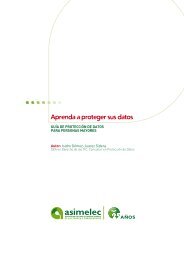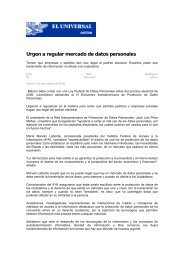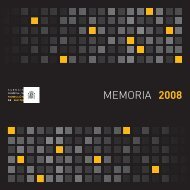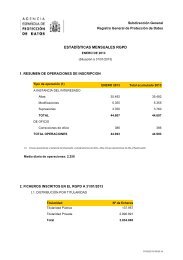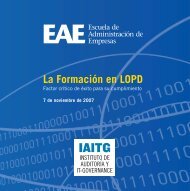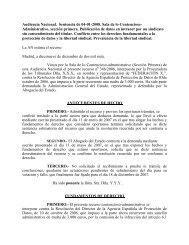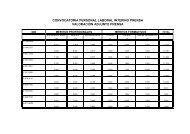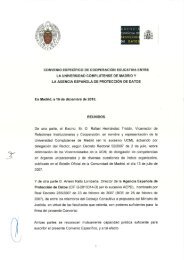access to public information and personal data protection 1 table of ...
access to public information and personal data protection 1 table of ...
access to public information and personal data protection 1 table of ...
Create successful ePaper yourself
Turn your PDF publications into a flip-book with our unique Google optimized e-Paper software.
ACCESS TO PUBLIC INFORMATIONAND PERSONAL DATA PROTECTIONHuixquilucan (Mexico State), 4 th November 2005It is important <strong>to</strong> remember that a medical record contains both objective <strong>and</strong>subjective <strong>data</strong>, <strong>and</strong> the latter are comprised <strong>of</strong> the physician’s opinions drawnfrom the patient’s objective <strong>data</strong>. In this respect, it is important <strong>to</strong> base theconcept on the premise that all the <strong>information</strong> related <strong>to</strong> the physical or mentalhealth <strong>of</strong> a <strong>data</strong> subject constitutes <strong>personal</strong> <strong>data</strong>, <strong>to</strong> which the <strong>data</strong> subject isentitled <strong>access</strong>. Thus, both the objective <strong>and</strong> the subjective <strong>data</strong> are regarded as<strong>personal</strong> <strong>data</strong>.In consequence, the <strong>data</strong> subject is clearly entitled <strong>to</strong> <strong>access</strong> the objective<strong>information</strong> without any restriction. However, there may be certain variations inthis interpretation with regards <strong>to</strong> the subjective <strong>data</strong>. A possibly valid approach<strong>to</strong> this issue is that the patient’s right <strong>to</strong> informed self-determination, whichattributes the individual the power <strong>to</strong> control <strong>and</strong> dispose <strong>of</strong> his/her <strong>personal</strong><strong>data</strong>, would be <strong>of</strong> greater weight. On the other h<strong>and</strong>, a case-by-case analysiscould also determine the situations in which certain <strong>information</strong> should be heldback, because, although it constitutes <strong>personal</strong> patient <strong>data</strong>, knowledge <strong>of</strong> thesame at any given time could cause injury <strong>to</strong> the life, safety or health <strong>of</strong> the <strong>data</strong>subject. The physicians’ notes could fall in<strong>to</strong> this category, in which case thefollowing two questions must be analysed: i) how <strong>to</strong> determine whether themedical <strong>information</strong> is objective, taken from clinical findings, or subjective?, <strong>and</strong>ii) whether knowledge <strong>of</strong> the <strong>information</strong> contained in the aforesaid subjectivenotes is part <strong>of</strong> a process <strong>of</strong> deliberation, <strong>and</strong>/or as such, could put the life, safetyor health <strong>of</strong> the patient at risk, <strong>and</strong> if not, whether such <strong>data</strong> must be made<strong>access</strong>ible, given that it encompasses in fine <strong>personal</strong> <strong>data</strong> (even when it iscomprised <strong>of</strong> speculation, deliberations or testing, the result <strong>of</strong> these practises isactually <strong>information</strong> related <strong>to</strong> an identified individual).V. CONCLUSIONSBased on the preceding analysis, the following conclusions may be drawn.1. There is a diversity <strong>of</strong> models <strong>and</strong> vast differences between thesystems that guarantee <strong>and</strong> protect the rights <strong>of</strong> <strong>access</strong> <strong>to</strong> <strong>information</strong><strong>and</strong> <strong>of</strong> <strong>personal</strong> <strong>data</strong>, which affect the actual <strong>and</strong> effective safeguard14



